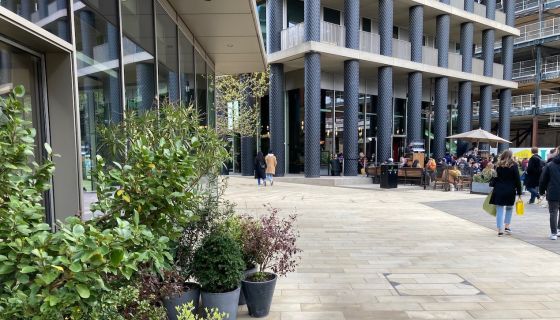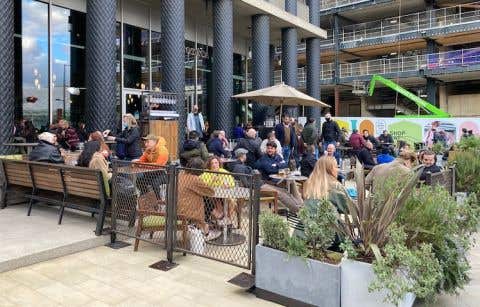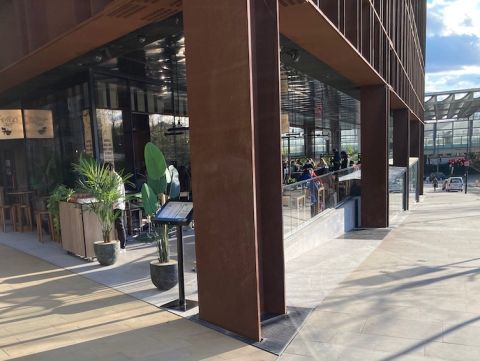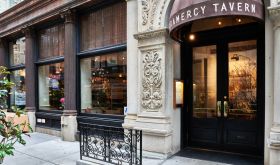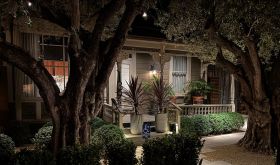Some time in the late nineteenth century, the maxim ‘the camera does not lie’ first featured in an American newspaper.
Over a hundred years later, two photographs of hospitality venues in London’s King’s Cross development continue to prove that this is still the case.
The picture above by Battle Bridge Place shows where three such venues meet. To the right, and just out of camera, is the packed terrace outside the German Gymnasium. Right ahead, is the similarly packed terrace of Vinoteca (see below). To the left is the completely empty terrace that surrounds Granger & Co, where the management have decided not to reopen despite the recent partial lifting of restrictions in England.
Then further up on the pedestrianised Pancras Road, where there are plenty of customers outside Drake & Morgan but none outside Kimchee, there is an outpost of Bao and Hoppers.
At 6.45 pm the street is cold and completely in the shade but further along on Goods Way, as shown below, there are plenty of customers enjoying excellent Sri Lankan food from Hoppers in the setting April sun.
These photos reveal the pluses and minuses of the new set of COVID-19 restrictions that came into force in England last Monday 12 April. As in life, they are far from fair.
The changes stipulate that restaurants and pubs may open but only outside, and with tables of no more than six customers. This is wonderful news for those with terraces and outdoor seating (standing outside pubs and bars is also allowed now) but it’s much less exciting for those with limited outdoor seating or none at all. And this is not the only constraint.
The popular Granger & Co has not opened in Battle Bridge Place because the outdoor seating that comes with the restaurant is too limited to make it worthwhile. Staffing a kitchen to cook the full menu that has made Bill Granger’s name, plus paying the waiting staff, would not be covered by the income from the few diners who can be seated at outdoor tables along the windows which, unfortunately, also include a number of tables that are in the sun only in the cool morning hours. Hence the decision to wait until Granger & Co can reopen the restaurant fully – an ironic twist for a restaurant that has made such an impact in this country serving the food of sunny Australia.
Outdoor seating on its own is therefore not enough. To make it work for any restaurateur, the outdoor seating must have the potential to accommodate enough customers; the tables must be close enough to the kitchen, which has to have the firepower to deliver hot food; and above all, the kitchen must not be in the basement.
This is why, for example, the first available slot for a table for two at Michelin-starred Le Gavroche is on 13 July at 9.30 pm, long after 17 May when indoor dining is due to be permitted once again. When the late Albert Roux first moved Le Gavroche to its Mayfair location, it was inconceivable that anyone would want to eat his French food outside. Serious food, food that took many hours of preparation as well as many hands to serve it, was best, and only, enjoyed out of the sunshine and indoors. The idea that food could be taken from a subterranean kitchen to anywhere further away than the length of the dining room was never, ever considered. (This was also the case at L’Escargot in Soho, first opened in 1926, with a minuscule space outdoors that has never, to the best of my knowledge, been used.)
Nor was this ever a consideration for any restaurant of note in Paris, Rome, Madrid or New York. Summers were too hot, winters too cold. There were tables on terraces with umbrellas and with wonderful views – I am thinking particularly of restaurants in Venice at this point – but they were often at the request of us sun-seeking, and sun-starved, northern Europeans.
This situation changed with the opening of the late Sir Terence Conran’s Le Pont de la Tour in 1991, which offered elegant French food, a good wine list (thank you, Walter), smart service, all in a location that offered wonderful views across the river to Tower Bridge, one of the most obvious symbols of England and London, its capital.
The timing of Pont de la Tour’s opening may not have been that propitious, just before the recession of the early 1990s, but it definitely acted as a catalyst for developers and restaurateurs to try to outdo each other in terms of views from tables. Later in that decade the Levin family opened The People’s Palace in the South Bank Centre and, just along the south bank of the Thames, Harvey Nichols opened their restaurant at the top of the Oxo Tower. Developers in general began to incorporate terraces into their designs for the future. Once this phenomenon was under way, technology and common sense played their part: outdoor heaters and lights; the handing-out of rugs; anything and everything that would make the customer feel warm and comfortable. And of course global warming has played its part.
British restaurateurs began to wake up to the financial benefits a terrace could bring. The first, and last, time I wrote about the increasing importance of terraces and outdoor eating in the capital was in late July 2009 – see Eating in the outside lane. Here I discussed with Ted Schama, of restaurant agents Shelley Sandzer, their benefits. The first is the sense of lifestyle. The second is the impact that they can have on sales, which are invariably higher than the restaurateur has budgeted for. Terraces lead to more relaxed customers who tend to stay for longer and therefore spend more money. But the biggest impact of any outdoor seating is the free advertising it generates. For anyone passing by, the sight of those enjoying a glass of wine and some food is the most immediate, most compelling reason to do exactly the same.
For that article I asked Schama about the rental cost of terrace space, to which his response was that it was roughly a quarter of the rent for the main restaurant. That proportion has stayed approximately the same but it is demand that has changed. Back then, Schama reported that some restaurateurs would not even look at a space with a terrace that would be unusable over the cold winter months, while others would not consider any space without a terrace.
Just as it has added value to any property with an outdoor space, COVID-19 has dramatically increased the appeal of any restaurant with a terrace, especially since, in Schama’s words, ‘what has become apparent is the severe lack of terraces, particularly in central London’.
I ended my article in 2009 with a short list of what I considered to be the six restaurant terraces with the most incredible views in the world. Here they are with one small change, with Berowra Waters, the Australian restaurant, now sadly closed, replaced with the Post Ranch Inn in California.
Sierra Mar, Post Ranch Inn, Big Sur, California postranchinn.com
Antica Locanda Mincio, Borghetto www.anticalocandamincio.it
Cip’s Club, Cipriani Hotel, Venice www.hotelcipriani.com
Le Café Marly, rue de Rivoli, Paris www.cafe-marly.com
Lucca, Bebek, Istanbul www.luccastyle.com
Sofitel Legend Old Cataract Hotel, Aswan www.all-accor.com

